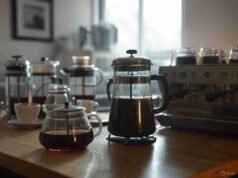Introduction
You’ve got the basics down—espresso, grind size, and crema are no longer alien words. Now’s the time to step up your home barista game. This advanced glossary will introduce you to intermediate and technical coffee jargon that will take your brewing to the next level. If you’re experimenting with manual brewers or mastering your espresso shots, these terms will help you understand the art of every cup.
Channeling
Channeling occurs when water passes unevenly through the coffee puck during espresso extraction. It is most commonly due to poor tamping or uneven distribution of grounds. Channeling produces under- and over-extraction in the same shot, affecting flavor and crema texture.
Avoid it by spreading your grounds evenly and using consistent tamping pressure.
Dose
Dose refers to the amount of ground coffee used for one shot of espresso, typically measured in grams. A common starting point is 18 to 20 grams for a double shot. Adjusting your dose changes the flavor intensity and extraction time, so it’s essential to dial it in based on taste.
Yield
Yield refers to the amount of liquid espresso that finds its way into your cup. It is typically measured in terms of grams or milliliters. You can establish a standard ratio, say 1:2—20g dose to yield around 40g of espresso. Measuring the yield helps you be consistent and balanced with your brews.
Brew Ratio
Brew ratio compares the amount of coffee to the yield of the beverage. For espresso, this is usually 1:2 or 1:2.5, and for pour-over might be 1:15. This ratio modifies strength and mouthfeel. It is essential to know brew ratios in making recipes.
Total Dissolved Solids (TDS)
TDS measures the level of the soluble content of the coffee that ends up in your cup. TDS is usually expressed as a percentage and read from a refractometer. While not absolutely required for beginners, understanding TDS can help advanced home baristas improve clarity and balance of flavors.
Coffee Accessories on Amazon
Extraction Time
Extraction time is how long water interacts with the coffee grounds. For espresso, this usually falls between 25 to 30 seconds. Timing your shots ensures you’re neither over- nor under-extracting your coffee, both of which can drastically alter flavor.
Pre-infusion
Pre-infusion is a preliminary low-pressure phase of espresso brewing. It allows the coffee puck to become saturated evenly before applying the entire pressure. The technique reduces channeling and provides balanced extraction, especially with fresh, very fine coffee grinds.
Blooming (Extended Concept)
You may already know that blooming releases gases off freshly ground coffee. On a more technical level, the bloom phase can be manipulated in terms of time and amount of water to regulate flavor extraction. Larger bloom phases extract more sweetness and body.
Agitation
Agitation refers to physically disturbing or moving the coffee grounds while brewing—stirring, swirling, or shaking. Used with pour-over, AeroPress, and French press brewing, agitation helps to induce extraction but needs to be controlled to avoid bitterness.
Retention
Retention refers to coffee grounds left behind in your grinder after a grind. Too much retention will lead to inconsistent doses and stale grinds in your subsequent brew. Baristas at home purge a minimal dose of coffee with every session to maintain consistency.
Conclusion
Stepping into the world of fancy coffee lingo doesn’t mean everything gets confused—it means your brewing becomes more intentional. Learning these words gives you the power to troubleshoot problems, refine techniques, and produce more tasty and uniform offerings. The farther you go on your home barista journey, so will your terminology—and that’s half the fun.












